Term Structure of Interest Rates#
The best thing about the future is that it comes one day at a time - Abraham Lincoln
The term structure of interest rates describes how interest rates and bond yields vary across different maturities, typically illustrated using a yield curve. We examine basic concepts such as spot rates, forward rates, par rates, and yield-to-maturity, along with techniques for modeling the term structure, including yield curve construction, splines, and bootstrapping. To gain intuitive insights into the dynamics of interest rate movements, we also apply low-rank approximation methods such as Principal Component Analysis (PCA) and Singular Value Decomposition (SVD).
# By: Terence Lim, 2020-2025 (terence-lim.github.io)
import re
from typing import List, Dict
from datetime import datetime
import numpy as np
import numpy.linalg as la
from scipy.interpolate import CubicSpline
import pandas as pd
from pandas import DataFrame, Series
import matplotlib.pyplot as plt
from sklearn.preprocessing import StandardScaler
from sklearn.pipeline import Pipeline
from sklearn.decomposition import PCA
from finds.readers import Alfred
from secret import credentials, paths
VERBOSE = 0
# %matplotlib qt
alf = Alfred(api_key=credentials['fred']['api_key'], convert_date=0, verbose=VERBOSE)
Interest Rates#
The frequency at which interest is compounded determines how an interest rate is measured. For example, an annual compounding rate assumes interest is compounded once per year, while a semi-annual compounding rate assumes two compounding periods per year.
The Annualized Percentage Yield (APY) or effective annual yield accounts for the effects of compounding. The conversion formula is:
where \( m \) represents the number of compounding periods per year.
To convert an interest rate \(R_m\) with compounding frequency \( m \) to an equivalent continuously compounded rate \(r\), we use the formula:
The spot rate for a given maturity is the zero-coupon rate applicable to that period. It is directly related to the discount factor:
The forward rate is the implied future interest rate derived from observed spot rates. Longer-term spot rates can be determined by compounding forward rates.
A bond’s yield to maturity (YTM) is the single discount rate that equates the bond’s present value of cash flows to its market price.
The par rate is the coupon rate at which a bond is issued at par value. A bond priced at par has a yield to maturity equal to its coupon rate.
The term structure of interest rates represents the relationship between yields and maturities. When plotted, it forms a yield curve. An upward-sloping curve indicates that forward rates are higher than spot and par rates, while a downward-sloping curve suggests the opposite.
Swap rates represent fixed interest rates exchanged for floating rates in an interest rate swap and are considered par rates.
# retrieve Constant Maturity Treasuries, excluding inflation-indexed and discontinued
cat = alf.get_category(115) # Fed H.15 Selected Interest Rates
print('Retrieved category:', cat['id'], cat['name'])
Retrieved category: 115 Treasury Constant Maturity
treas = DataFrame.from_dict(
{s['id']: [s['observation_start'], s['frequency'], s['title'].split(',')[0][44:]]
for s in cat['series'] if 'Inflation' not in s['title'] and
'DISCONT' not in s['title'] and s['frequency'] in ['Daily', 'Monthly']},
columns = ['start', 'freq', 'title'],
orient='index').sort_values(['freq', 'start'])
print("Constant Maturity Treasuries in FRED")
pd.set_option('display.max_colwidth', None)
treas
Constant Maturity Treasuries in FRED
| start | freq | title | |
|---|---|---|---|
| DGS1 | 1962-01-02 | Daily | 1-Year Constant Maturity |
| DGS10 | 1962-01-02 | Daily | 10-Year Constant Maturity |
| DGS20 | 1962-01-02 | Daily | 20-Year Constant Maturity |
| DGS3 | 1962-01-02 | Daily | 3-Year Constant Maturity |
| DGS5 | 1962-01-02 | Daily | 5-Year Constant Maturity |
| DGS7 | 1969-07-01 | Daily | 7-Year Constant Maturity |
| DGS2 | 1976-06-01 | Daily | 2-Year Constant Maturity |
| DGS30 | 1977-02-15 | Daily | 30-Year Constant Maturity |
| DGS3MO | 1981-09-01 | Daily | 3-Month Constant Maturity |
| DGS6MO | 1981-09-01 | Daily | 6-Month Constant Maturity |
| DGS1MO | 2001-07-31 | Daily | 1-Month Constant Maturity |
| GS1 | 1953-04-01 | Monthly | 1-Year Constant Maturity |
| GS10 | 1953-04-01 | Monthly | 10-Year Constant Maturity |
| GS20 | 1953-04-01 | Monthly | 20-Year Constant Maturity |
| GS3 | 1953-04-01 | Monthly | 3-Year Constant Maturity |
| GS5 | 1953-04-01 | Monthly | 5-Year Constant Maturity |
| GS7 | 1969-07-01 | Monthly | 7-Year Constant Maturity |
| GS2 | 1976-06-01 | Monthly | 2-Year Constant Maturity |
| GS30 | 1977-02-01 | Monthly | 30-Year Constant Maturity |
| GS3M | 1981-09-01 | Monthly | 3-Month Constant Maturity |
| GS6M | 1981-09-01 | Monthly | 6-Month Constant Maturity |
| GS1M | 2001-07-01 | Monthly | 1-Month Constant Maturity |
# infer maturity from label
daily = pd.concat([alf(s, freq='D')
for s in treas.index if treas.loc[s, 'freq']=='Daily'],
axis=1, join='outer')
daily.columns = [int(re.sub('\D', '', col)) * (1 if col[-1].isalpha() else 12) # MO or M
for col in daily.columns] # infer maturity in months from label
daily = daily.rename_axis(columns='maturity').sort_index(axis=1)
daily
| maturity | 1 | 3 | 6 | 12 | 24 | 36 | 60 | 84 | 120 | 240 | 360 |
|---|---|---|---|---|---|---|---|---|---|---|---|
| date | |||||||||||
| 1962-01-02 | NaN | NaN | NaN | 3.22 | NaN | 3.70 | 3.88 | NaN | 4.06 | 4.07 | NaN |
| 1962-01-03 | NaN | NaN | NaN | 3.24 | NaN | 3.70 | 3.87 | NaN | 4.03 | 4.07 | NaN |
| 1962-01-04 | NaN | NaN | NaN | 3.24 | NaN | 3.69 | 3.86 | NaN | 3.99 | 4.06 | NaN |
| 1962-01-05 | NaN | NaN | NaN | 3.26 | NaN | 3.71 | 3.89 | NaN | 4.02 | 4.07 | NaN |
| 1962-01-08 | NaN | NaN | NaN | 3.31 | NaN | 3.71 | 3.91 | NaN | 4.03 | 4.08 | NaN |
| ... | ... | ... | ... | ... | ... | ... | ... | ... | ... | ... | ... |
| 2025-02-21 | 4.36 | 4.32 | 4.30 | 4.15 | 4.19 | 4.19 | 4.26 | 4.35 | 4.42 | 4.69 | 4.67 |
| 2025-02-24 | 4.36 | 4.31 | 4.30 | 4.15 | 4.13 | 4.17 | 4.23 | 4.32 | 4.40 | 4.69 | 4.66 |
| 2025-02-25 | 4.34 | 4.30 | 4.28 | 4.12 | 4.07 | 4.08 | 4.12 | 4.21 | 4.30 | 4.59 | 4.55 |
| 2025-02-26 | 4.35 | 4.31 | 4.28 | 4.12 | 4.05 | 4.04 | 4.06 | 4.16 | 4.25 | 4.55 | 4.51 |
| 2025-02-27 | 4.38 | 4.32 | 4.28 | 4.13 | 4.07 | 4.05 | 4.09 | 4.19 | 4.29 | 4.59 | 4.56 |
15774 rows × 11 columns
monthly = pd.concat([alf(s, freq='M')
for s in treas.index if treas.loc[s, 'freq']=='Monthly'],
axis=1, join='outer')
monthly.columns = [int(re.sub('\D', '', col)) * (1 if col[-1].isalpha() else 12) # MO or M
for col in monthly.columns] # infer maturity in months from label
monthly = monthly.rename_axis(columns='maturity').sort_index(axis=1)
monthly
| maturity | 1 | 3 | 6 | 12 | 24 | 36 | 60 | 84 | 120 | 240 | 360 |
|---|---|---|---|---|---|---|---|---|---|---|---|
| date | |||||||||||
| 1953-04-30 | NaN | NaN | NaN | 2.36 | NaN | 2.51 | 2.62 | NaN | 2.83 | 3.08 | NaN |
| 1953-05-31 | NaN | NaN | NaN | 2.48 | NaN | 2.72 | 2.87 | NaN | 3.05 | 3.18 | NaN |
| 1953-06-30 | NaN | NaN | NaN | 2.45 | NaN | 2.74 | 2.94 | NaN | 3.11 | 3.21 | NaN |
| 1953-07-31 | NaN | NaN | NaN | 2.38 | NaN | 2.62 | 2.75 | NaN | 2.93 | 3.12 | NaN |
| 1953-08-31 | NaN | NaN | NaN | 2.28 | NaN | 2.58 | 2.80 | NaN | 2.95 | 3.10 | NaN |
| ... | ... | ... | ... | ... | ... | ... | ... | ... | ... | ... | ... |
| 2024-09-30 | 5.06 | 4.92 | 4.55 | 4.03 | 3.62 | 3.51 | 3.50 | 3.60 | 3.72 | 4.10 | 4.04 |
| 2024-10-31 | 4.92 | 4.72 | 4.44 | 4.20 | 3.97 | 3.90 | 3.91 | 3.99 | 4.10 | 4.44 | 4.38 |
| 2024-11-30 | 4.71 | 4.62 | 4.43 | 4.33 | 4.26 | 4.21 | 4.23 | 4.29 | 4.36 | 4.63 | 4.54 |
| 2024-12-31 | 4.50 | 4.39 | 4.32 | 4.23 | 4.23 | 4.22 | 4.25 | 4.32 | 4.39 | 4.66 | 4.58 |
| 2025-01-31 | 4.42 | 4.34 | 4.26 | 4.18 | 4.27 | 4.33 | 4.43 | 4.53 | 4.63 | 4.92 | 4.85 |
862 rows × 11 columns
# mapper to display maturity months as labels
mapper = lambda month: f"{month}-Month" if month < 12 else f"{int(month/12)}-Year"
cols = [3, 24, 120, 360]
fig, ax = plt.subplots(figsize=(10, 6))
daily[cols].rename(columns=mapper).plot(ax=ax, rot=0)
plt.title('Daily Constant Maturity Treasury Rates')
plt.ylabel('par yield')
plt.tight_layout()
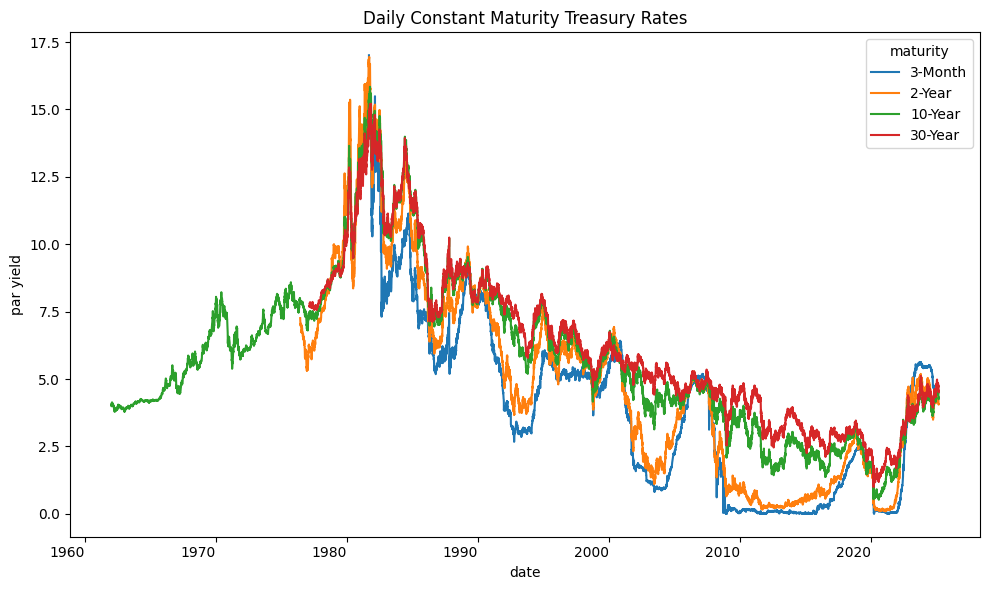
cols = [12, 60, 120, 240]
fig, ax = plt.subplots(figsize=(10, 6))
monthly[cols].rename(columns=mapper).plot(ax=ax, rot=0)
plt.title('Monthly Constant Maturity Treasury Rates')
plt.ylabel('par yield')
plt.tight_layout()
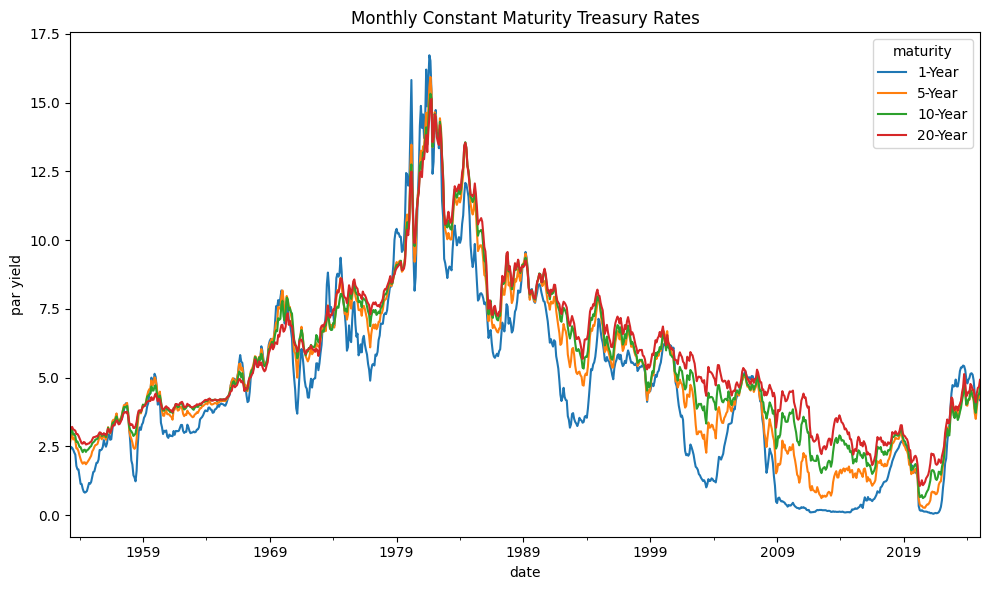
Yield Curve#
The U.S. Treasury’s official yield curve is a par yield curve constructed using a monotone convex method. This curve is based on indicative bid-side price quotations collected by the Federal Reserve Bank of New York at approximately 3:30 PM each trading day.
Historically, the Treasury used a quasi-cubic Hermite spline (HS) method to construct the yield curve. This approach interpolated yields directly from observed market data under the assumption that the resulting curve was a par yield curve. However, since December 6, 2021, the monotone convex method has been the standard.
Constant Maturity Treasury (CMT) yields are derived from the Treasury’s par yield curve and represent bond-equivalent yields for semiannual interest-paying securities. These yields are expressed on a simple annualized basis rather than an effective annual yield (APY) basis, which incorporates compounding effects. To convert a CMT yield to APY, use:
Splines#
Spline interpolation is used to estimate yields at maturities not directly observed in the market. A piecewise cubic polynomial ensures smooth transitions between maturities and maintains twice continuous differentiability.
yield_curve = dict()
curve_dates = sorted(daily.dropna().index[-1:0:-(5*252)])
for date in curve_dates:
yield_curve[date] = CubicSpline(
x=daily.columns.to_list(), y=daily.loc[date].values, bc_type='clamped')
# Plot historical yield curves
fig, ax = plt.subplots(figsize=(10, 6))
X = list(range(1, 361))
for col, (date, curve) in enumerate(yield_curve.items()):
ax.plot(X, curve(X), label=date.strftime('%Y-%m-%d'), color=f"C{col}")
plt.legend()
for col, (date, curve) in enumerate(yield_curve.items()):
daily.loc[date].plot(ax=ax, marker='o', ls='', color=f"C{col}", label=None)
plt.title('Interpolated Treasury Yield Curves')
plt.xlabel('Maturity (months)')
plt.tight_layout()
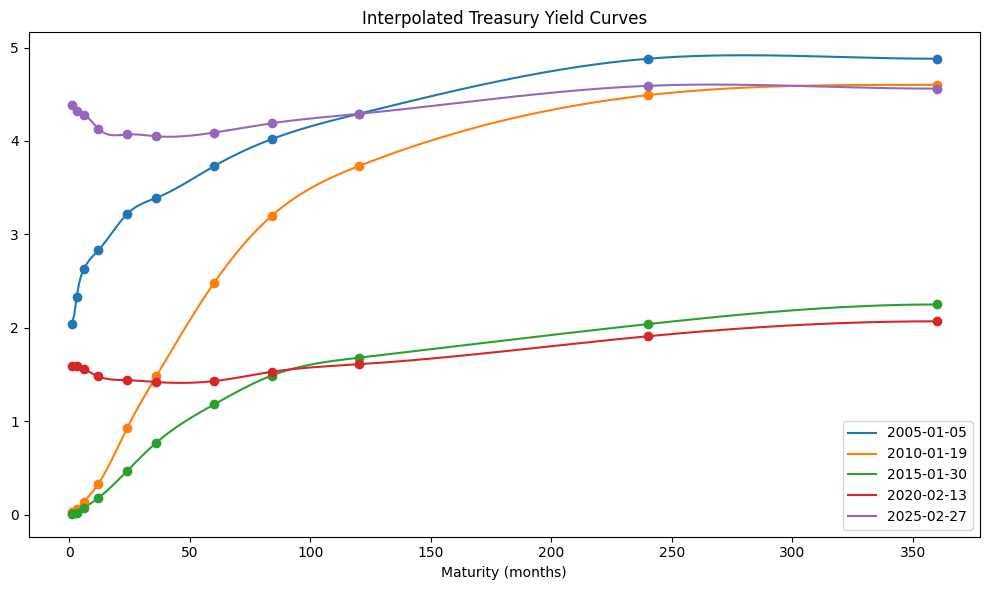
Bootstrap Method#
Bootstrapping is a process used to derive spot rates by progressively solving for zero-coupon rates using available bond data. This iterative approach fits spot rates to increasingly longer maturities.
# To bootstrap 6-month spot rates from 6-month par yields
m = 2 # compounding periods per year
# list of 6-monthly maturities
maturities = list(range(int(12/m), daily.columns[-1]+1, int(12/m)))
# Helper to bootstrap spot rates from par yield curve
def bootstrap_spot(coupon: float, spots: List[float], m: int, price: float=1) -> float:
"""Compute spot rate to maturity of par bond from yield and sequence of spots
Args:
coupon : Annual coupon rate
spots : Simple annual spot rates each period (excluding last period before maturity
m : Number of compounding periods per year
price: Present value of bond
Returns:
Simple spot interest rate till maturity
"""
if not spots: # trivial one-period bond
return coupon / price
n = len(spots) + 1 # number of coupons through maturity
# discount factors from given spot rates
discount = [(1 + spot/m)**(-(1+t)) for t, spot in enumerate(spots)]
# nominal amount of last payment
last_payment = 1 + coupon/m
# infer present value of last coupon and principal
last_pv = price - np.sum(discount) * coupon/m
# compute discount factor and annualize the effective rate
spot = ((last_payment/last_pv)**(1/n) - 1) * m
return spot
# select most recent yield curve
curve_date = curve_dates[-1]
yields = [yield_curve[curve_date](t) / 100 for t in maturities]
spots = []
for coupon in yields:
spots.append(bootstrap_spot(coupon=coupon, spots=spots, m=m))
DataFrame({curve_date.strftime('%Y-%m%d'): spots}, index=maturities).head()
| 2025-0227 | |
|---|---|
| 6 | 0.042800 |
| 12 | 0.041285 |
| 18 | 0.040591 |
| 24 | 0.040684 |
| 30 | 0.040639 |
Helper to compute bond prices
def bond_price(coupon: float, n: int, m: int, yields: float | List[float],
par: float = 1) -> float:
"""Compute present value of bond given spot rates or yield-to-maturity
Args:
coupon : Annual coupon rate
n : Number of remaining coupons
m : Number of compounding periods per year
yields : Simple annual yield-to-maturity or spot rates each period
par : face or par value of bond
Returns:
Present value of bond
"""
if not pd.api.types.is_list_like(yields):
yields = [yields] * n # same yield-to-maturity is spot rate every period
assert len(yields) == n, "Number of yields must equal number of couponds"
pv = [(1 + yields[t-1]/m)**(-t) * (coupon/m + (par if t == n else 0))
for t in range(1, n+1)] # discount every period's payment, plus last face
return np.sum(pv)
# Sanity-check par bond price given spots
for t in range(len(yields)):
price = bond_price(coupon=yields[t], n=t+1, m=2, yields=spots[:(t+1)])
assert np.allclose(price, 1.0) # discounted payments at spot rates must equal price
# Compute forward rates from spot rates
def forwards_from_spots(spots: List[float], m: int, skip: int=0) -> List[float]:
"""Compute forward rates given spot rates
Args:
spots : Sequence of simple annual spot rates
m : Number of compounding periods per year
skip: Number of initial periods skipped
Returns:
List of forward rates, excluding first period of spot rates input
"""
result = []
assert len(spots) >= 2, "Require at least two spot rates as input"
for t in range(1, len(spots)):
n = skip + t
numerator = (1 + spots[n]/m)**n # discounted value of period n
denominator = (1 + spots[n-1]/m)**(n-1) # discounter value of period n-1
result.append(((numerator / denominator) - 1) * m)
return result
forwards = [spots[0]] + forwards_from_spots(spots=spots, m=m)
Plot current yield curve
fig, ax = plt.subplots(figsize=(10, 6))
(daily.loc[curve_date] / 100).plot(marker='*', ls='', color="C0")
X = range(1, maturities[-1]+1)
ax.plot(X, [yield_curve[curve_date](t) / 100 for t in X], marker='', ls='-', color="C0")
ax.plot(maturities, spots, marker='', ls='-', color="C1")
ax.plot(maturities, forwards, marker='', ls='-', color="C2")
plt.legend(['CMT Constant Maturity Yields', 'Cubic Spline Interpolation',
'Spot Rates (computed 6-monthly)', 'Forward Rates (computed 6-monthly)'])
plt.title(f"Yield Curve on {curve_date.strftime('%Y%m%d')}")
plt.xlabel('Maturity (months')
plt.tight_layout()
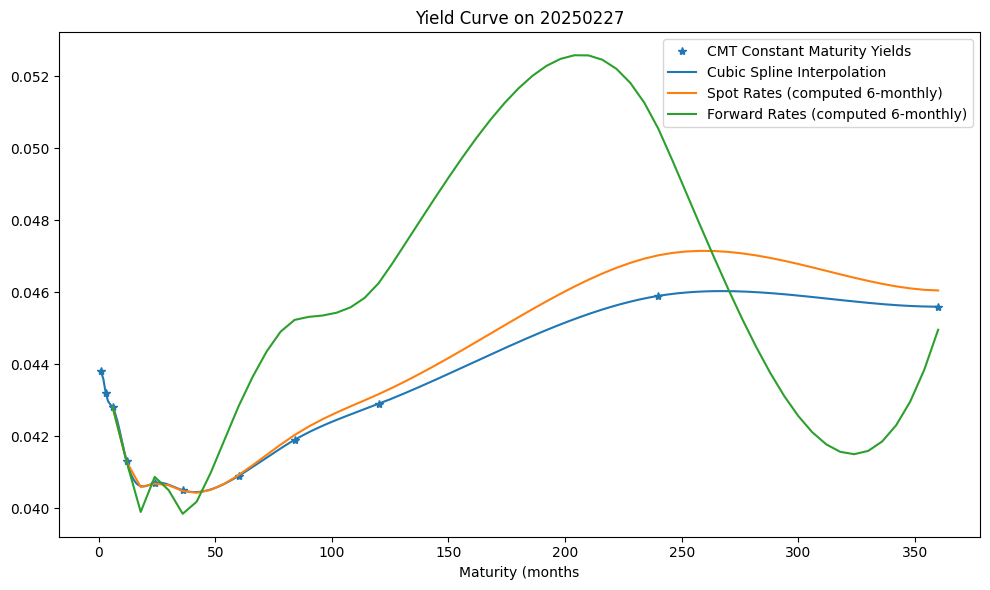
There are more sophisticated methods for fitting yield curves to treasuries prices, such as this model by Liu and Wu (2021)
# Download reconstructed yield curve data by Liu and Wu (2021)
# file_id from https://sites.google.com/view/jingcynthiawu/yield-data
file_id = '1-wmStGZHLx55dSYi3gQK2vb3F8dMw_Nb' # monthly
#file_id = '11HsxLl_u2tBNt3FyN5iXGsIKLwxvVz7t' # daily
src = "https://drive.google.com/uc?export=download&id={}".format(file_id) # to load from gdrive
df = pd.ExcelFile(src).parse()
dates = np.where(df.iloc[:, 0].astype(str).str[0].str.isdigit())[0] # locate first date cell
liuwu = DataFrame(np.exp(df.iloc[dates,1:361].astype(float).values/100) - 1,
index=(pd.to_datetime(df.iloc[dates, 0], format="%Y%m")
+ pd.offsets.MonthEnd(1)),
columns=np.arange(1, 361))
# Plot historical reconstructed rates as 3D surface
from mpl_toolkits.mplot3d import Axes3D
r = liuwu.dropna()
X, Y = np.meshgrid(r.index.map(lambda x: float(str(x)[:4]) + float(str(x)[5:7])/12),
r.columns.astype(float)/12)
#X, Y = np.meshgrid((r.index//10000) + ((((r.index//100)%100)-1)/12),
# r.columns.astype(float)/12)
Z = r.T.to_numpy()*100
fig = plt.figure(num=1, clear=True, figsize=(10, 8))
ax = plt.axes(projection='3d')
f = ax.plot_surface(X, Y, Z, cmap='coolwarm', linewidth=0, antialiased=True)
ax.set_title('Reconstructed Treasury Interest Rates [Liu and Wu (2020)]')
ax.set_xlabel('date')
ax.set_ylabel('maturity (years)')
ax.set_zlabel('annual yield (%)')
fig.colorbar(f, shrink=0.5, aspect=5)
plt.tight_layout()
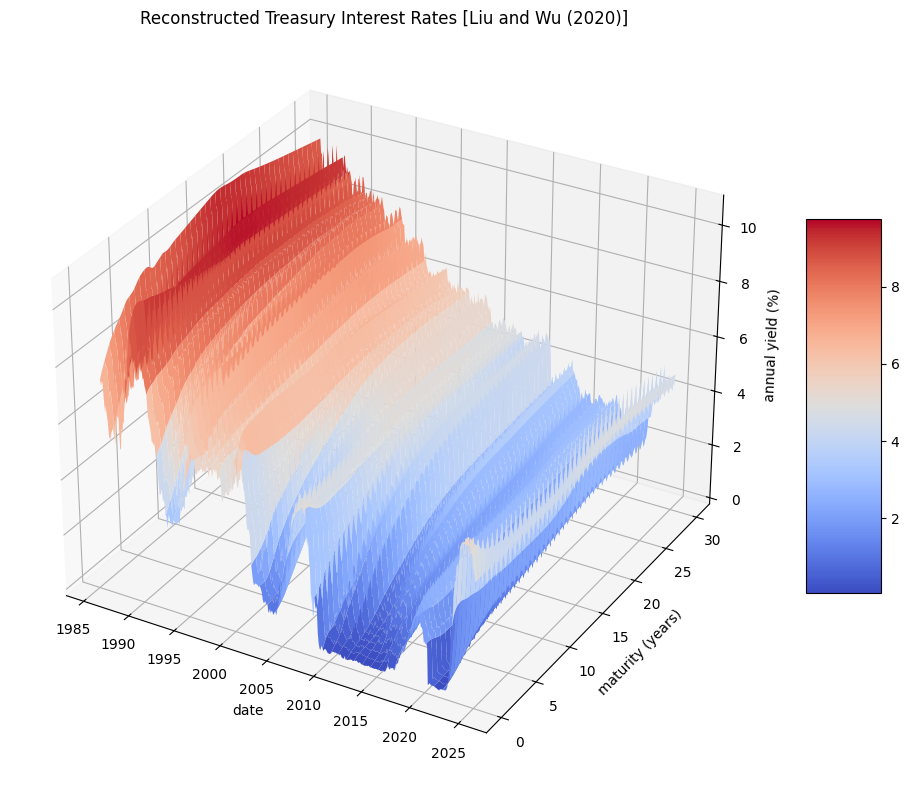
# Plot historical Yield Curves
curve_dates = sorted(liuwu.index[-1:0:-(7*12)])[-4:]
for date in curve_dates:
yield_curve[date] = CubicSpline(
x=monthly.columns.to_list(), y=monthly.loc[date].values, bc_type='clamped')
fig, axes = plt.subplots(2,2, figsize=(12, 8), sharey=True, sharex=True)
axes = axes.flatten()
for num, (curve_date, ax) in enumerate(zip(curve_dates, axes)):
# fit yields
yields = [yield_curve[curve_date](t) / 100 for t in maturities]
# compute spots
spots = []
for coupon in yields:
spots.append(bootstrap_spot(coupon=coupon, spots=spots, m=m))
# compute forwards
forwards = [spots[0]] + forwards_from_spots(spots=spots, m=m)
# plot
(monthly.loc[curve_date] / 100).plot(marker='*', ls='', color="C0", ax=ax) # CMT yield
X = range(1, maturities[-1]+1)
ax.plot(X, [yield_curve[curve_date](t) / 100 for t in X], marker='', ls='-', color="C0")
ax.plot(maturities, spots, marker='', ls='-', color="C1")
ax.plot(maturities, forwards, marker='', ls='-', color="C2")
liuwu.loc[curve_date].plot(ax=ax, marker='', ls=':', color="C3") # Liu and Wu
ax.set_title(f"{curve_date.strftime('%Y-%m-%d')}")
ax.set_xlabel('Maturity (months)')
if not num:
ax.legend(['CMT Constant Maturity Yields', 'Cubic Spline Interpolation',
'Spot Rates (computed 6-monthly)', 'Forward Rates (computed 6-monthly)',
'Reconstructed Yield Curve: Liu and Wu(2021)'])
plt.tight_layout()

Principal Component Analysis (PCA)#
Principal Component Analysis (PCA), also referred to as eigendecomposition, involves rotating the data space so that each axis captures the maximum variance. We apply PCA to identify the key factors influencing daily interest rate in Constant Maturity Treasury (CMT) rates.
The number of factors in PCA equals the number of interest rate maturities analyzed. The first principal component accounts for 84% of daily yield variance, while the first two components explain almost 99%. The first three components together account for approximately 99.9%, meaning most of the uncertainty in yield changes can be attributed to these factors.
X = daily.dropna()
Y = StandardScaler().fit_transform(X)
pca = PCA().fit(Y)
DataFrame({'Cumulative Variance Explained': pca.explained_variance_ratio_.cumsum()},
index=[f"PC {c+1}" for c in range(pca.n_components_)])
| Cumulative Variance Explained | |
|---|---|
| PC 1 | 0.841980 |
| PC 2 | 0.986916 |
| PC 3 | 0.997595 |
| PC 4 | 0.998925 |
| PC 5 | 0.999401 |
| PC 6 | 0.999727 |
| PC 7 | 0.999866 |
| PC 8 | 0.999929 |
| PC 9 | 0.999965 |
| PC 10 | 0.999986 |
| PC 11 | 1.000000 |
# Scree plot
scree = Series(pca.explained_variance_ratio_,
index=np.arange(1, Y.shape[1] + 1))
fig, ax = plt.subplots(figsize=(10, 6))
scree[:10].plot(kind='bar', rot=0, width=.8, ax=ax)
ax.set_title('Scree Plot: PCA of Daily Treasury Yields')
ax.set_ylabel("Percent Variance Explained")
ax.set_xlabel("Principal Component")
plt.tight_layout()
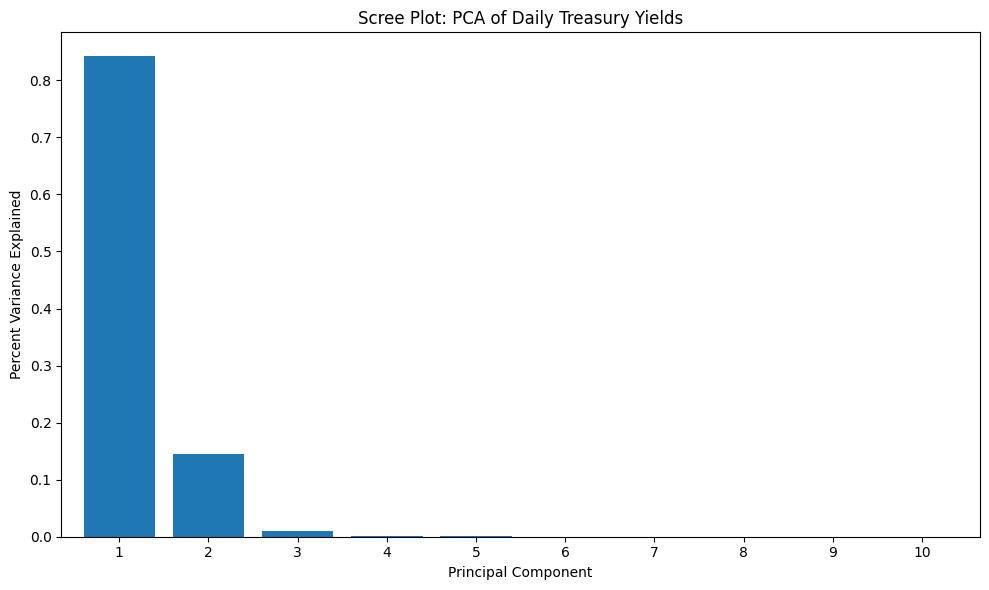
# Factor Loadings
Z = pca.components_[:3, :].T * pca.singular_values_[:3].reshape(1, 3)
loadings = DataFrame(Z, columns=[f"Factor {n+1}" for n in range(3)], index=X.columns/12)
fig, ax = plt.subplots(figsize=(10, 6))
loadings.plot(ax=ax)
ax.set_title(f"Most Important Factors Driving Treasury Yields"
f" ({str(X.index[0])[:7]} to {str(X.index[-1])[:7]})")
ax.set_xlabel('Maturity (years)')
ax.set_ylabel('Factor Loading')
Text(0, 0.5, 'Factor Loading')
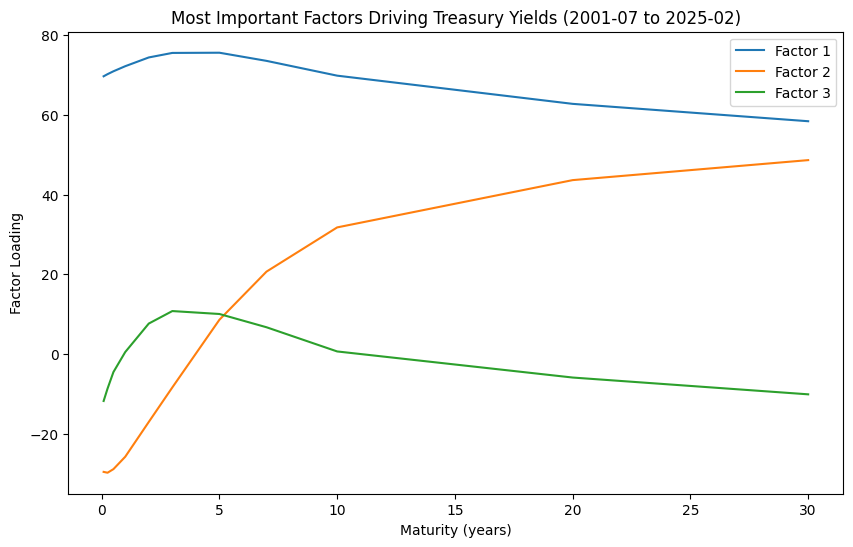
Key Factors Affecting Treasury Yields
Level Factor – Represents a parallel shift in yields across all maturities.
Slope Factor – Indicates changes in the steepness of the yield curve, where short-term and long-term rates move in opposite directions.
Twist Factor – Describes changes in the curvature of the yield curve, where intermediate rates move differently from short- and long-term rates.
Singular Value Decomposition (SVD)#
Singular Value Decomposition (SVD) is a factorization method that decomposes a matrix into three components:
where:
\( U \) and \( V \) are orthogonal matrices representing rotations.
\( S \) is a diagonal matrix containing singular values (scaling factors).
SVD generalizes eigenvalue decomposition:
where \( \Lambda \) contains the eigenvalues.
A goal of both PCA and SVD is to approximate the original data matrix with a lower-dimensional presentation, with the most important eigen- and singular vectors associated with the largest eigenvalues and singular values respectively.
Eigenvalues (\(\lambda\)) in PCA correspond to squared singular values in SVD.
Principal components (columns of \( V \)) are the eigenvectors or right singular vectors.
Loadings are obtained by multiplying each principal component by its corresponding singular value.
Projections (scores) are computed by projecting data onto the principal components.
# A is num_samples (N) by num_features (K) data matrix, standardized by column
A = daily.dropna().values
A = (A - A.mean(axis=0)) / A.std(axis=0) # subtract mean, divide by std
N, K = A.shape
A.shape
(5896, 11)
# svd x is related to pca of x'x
u, s, vT = np.linalg.svd(A, full_matrices=False)
v = vT.T # transposed right singular vector was returned
The eigenvalues (\(\lambda\)) of PCA
can be retrieved as (N-1) times pca.explained_variance_
are equal to the squares of the singular values (\(s\) from SVD)
# s**2 = lambda = N * explained_variance
assert np.allclose((N-1) * pca.explained_variance_, s**2), 'eigenvalues values'
assert np.allclose(pca.singular_values_, s), "singular values"
The components (columns of \(V\)) of an eigendecomposition
are also called the eigenvectors, or right singular vectors from the SVD
can be retrieved from the rows of pca.components_, or
are the rows of \(V^T\) (identically, the columns of \(V\) from SVD)
Relatedly:
loadings are computed by multiplying each component by its corresponding singular value \(v \cdot s\)
# components and right singular vectors are identical up to sign flip
for pc in range(K):
assert (np.allclose(vT[pc, :], pca.components_[pc, :]) or
np.allclose(vT[pc, :], -pca.components_[pc, :]))
# square of loadings is same as square of data matrix, i.e. the covariance matrix
loadings = np.diag(pca.singular_values_) @ pca.components_
assert np.allclose(A.T @ A, loadings.T @ loadings), 'square matrix'
The projections of PCA
are also known as the scores or co-ordinates
are computed by projecting the data matrix on the components \(A \cdot V\)
or by scaling each left singular vector by its corresponding singular value \(u \cdot s\)
can be retrieved by calling pca.transform() on the data matrix
# assert: x @ v == transform(x) (aka projection on components)
y = pca.transform(A)
for pc in range(K):
assert np.allclose((A@v)[:,pc], -y[:,pc]) or np.allclose((A@v)[:,pc], y[:,pc])
assert np.allclose(u[:,pc]*s[pc], -y[:,pc]) or np.allclose(u[:,pc]*s[pc], y[:,pc])
Low-Rank Approximations#
PCA and SVD allow approximating the original data matrix with a lower-dimensional representation. A rank-k approximation is a technique find a matrix \(A_k\) with lower rank \(k\) that is as close as possible to the original matrix \(A\) in terms of some measure, typically the Frobenius norm. This approximation reduces the complexity of the data while retaining its most important features.
Low-rank approximation by PCA#
ATA = A.T.dot(A)
eigval, eigvec = (N-1)*pca.explained_variance_, pca.components_.T
assert np.allclose(eigvec.dot(np.diag(eigval)).dot(eigvec.T), ATA), "pca error"
print('rank-K PCA approximation:')
DataFrame.from_dict({k: (la.norm(
eigvec[:, :k].dot(np.diag(eigval[:k])).dot(eigvec[:, :k].T) - ATA)/la.norm(ATA))
for k in range(1, 5)}, orient='index', columns=['Frobenius Norm'])\
.rename_axis(index='K')
rank-K PCA approximation:
| Frobenius Norm | |
|---|---|
| K | |
| 1 | 0.170097 |
| 2 | 0.012614 |
| 3 | 0.001707 |
| 4 | 0.000700 |
Low-rank approximation by SVD#
\(A \approx A_k = U_{[:k]} S_{[:k]} V_{[:k]}'\)
assert np.allclose(u.dot(np.diag(s)).dot(v.T), A), "svd error"
print('rank-K SVD approximation:')
DataFrame.from_dict({k: la.norm(
u[:, :k].dot(np.diag(s[:k])).dot(v[:, :k].T) - A) / la.norm(A)
for k in range(1, 5)}, orient='index', columns=['Frobenius Norm'])\
.rename_axis(index='K')
rank-K SVD approximation:
| Frobenius Norm | |
|---|---|
| K | |
| 1 | 0.397517 |
| 2 | 0.114383 |
| 3 | 0.049039 |
| 4 | 0.032781 |
References:
FRM Part 1 Exam Book Valuation and Risk Models, Chapter 12-13
Yan Liu and Jing Cynthia Wu “Reconstructing the Yield Curve”, Journal of Financial Economics, 2021, 142 (3), 1395-1425.